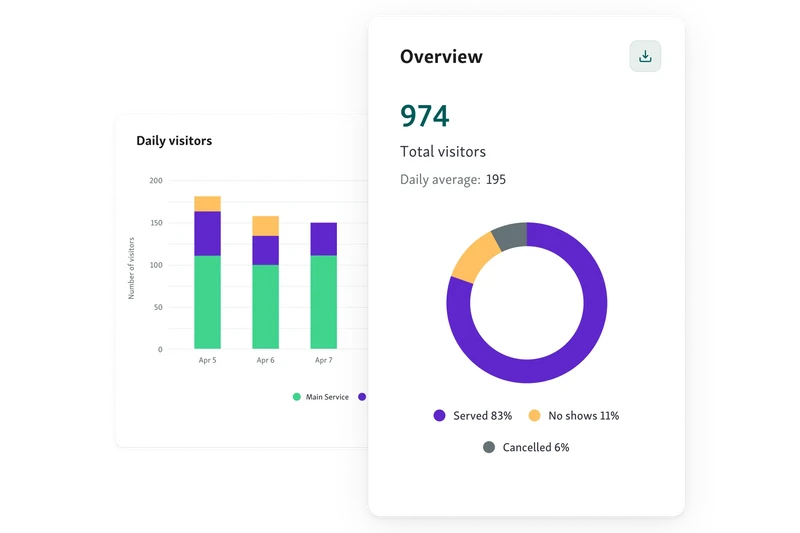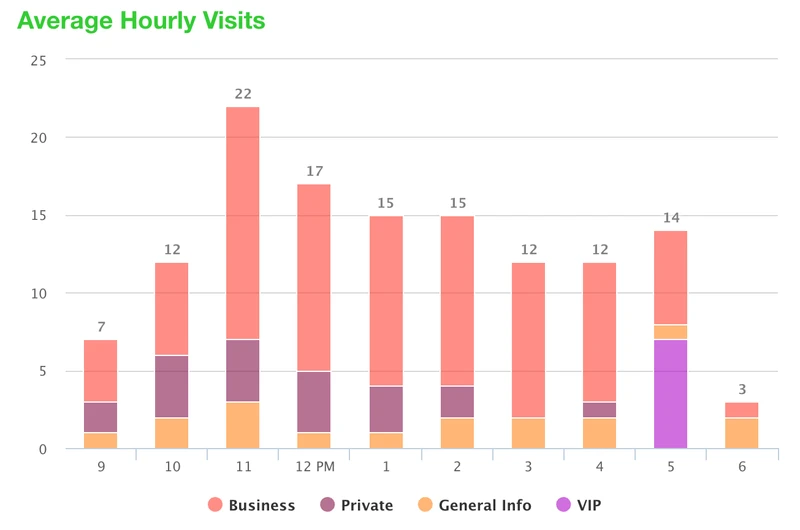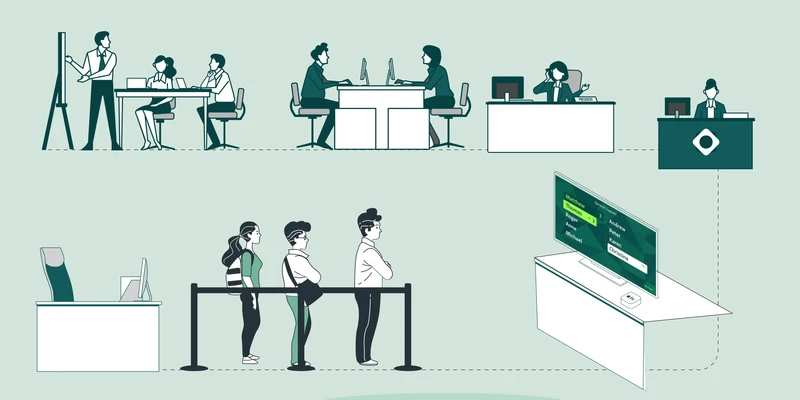At its core, queueing theory is a mathematical framework used to predict wait times, service capacity, and traffic volume in systems like DMVs, city halls, and clinics.
While these models offer valuable insights, they often fall short in real-world government settings where human behavior, resource limitations, and the psychology of queueing play a much bigger role.
Practical queue management solutions step in where theory stops—adapting to fluctuating foot traffic and staff availability in real time.
This blog explores the applications of queueing theory, its limitations, and how modern tools help public sector agencies deliver smoother, more citizen-friendly service experiences.
What is queuing theory?
Queuing theory is the mathematical study of waiting lines. It analyzes how entities like citizens in a government office—arrive, wait, and receive service. Originally developed to model telephone networks, it now applies across various public sector environments to understand and optimize service systems under different demand volumes.
At its core, queueing theory focuses on several key elements:
Arrival rate (λ): How frequently people enter the queue.
Service rate (μ): How quickly staff can serve each person.
Queue discipline: The rule used to serve people, such as First-In-First-Out (FIFO).
System capacity: The maximum number of people the system can handle at once.
However, these models often rely on simplified assumptions like steady arrival patterns and uniform service times that rarely reflect the variability and unpredictability of real-world government service environments.
How to apply queuing theory in public services?
Queueing theory offers public sector agencies a structured, mathematical way to understand service volume and manage demand more effectively. While theoretical, these models have practical value when applied thoughtfully. Here's how they’re used:
Workforce planning
Queueing models calculate optimal staffing levels by analyzing arrival rates (λ) and service rates (μ). This allows agencies to determine how many clerks are needed during different times of day to prevent excessive wait times. The result is smarter scheduling and better staff utilization during peak periods or slower hours.
Example: A city permit office used arrival data to shift two extra clerks to mornings, cutting average wait time by 25%.
Infrastructure design
The layout of service areas—whether it's DMV counters or a housing office—can be optimized using queue simulations. For example, comparing a single serpentine queue versus individual lines helps reduce perceived unfairness and improves throughput. These models help design physical spaces that support smoother flow.
Example: A courthouse replaced multiple entry lines with one central queue, reducing line-cutting complaints and improving flow.
Helpful read - How Improving Citizen Flow Can Deliver Measurable ROI
Appointment modeling
By integrating queueing equations with real-time appointment data, agencies can simulate how walk-ins and booked appointments interact. This supports better planning for hybrid service models and ensures staff are not overwhelmed by unexpected volume, helping to maintain consistent service levels.
Example: A public health clinic ran simulations that helped cap daily walk-in slots, keeping total service time within targets.
Stress-testing services
Public offices can use simulations based on queueing theory to predict performance during unusual spikes—like tax season or system outages. These models let agencies visualize bottlenecks and prepare contingency plans before problems arise, making services more resilient under pressure.
Example: A tax office simulated April peak traffic and added a temporary kiosk, which helped prevent hallway crowding.
Also read - What Are You Waiting For: The Queuing Theory in Practice
The Limits of Queueing Theory in Real-Life Settings
While queueing theory provides a strong mathematical foundation for understanding wait times and service flow, its application in the public sector has real-world limitations. Many public offices face dynamic and human-centric challenges that theory alone cannot solve.
Human behavior
Mathematical models assume rational actors, but citizens don’t always behave predictably. People may abandon queues out of frustration, arrive in unexpected bursts, or become agitated if they feel ignored. Emotions, stress, and perception play a major role in queue dynamics—something theory rarely accounts for.
Complexity of service types
Public sector offices often manage multiple service categories—renewing IDs, processing permits, or handling legal forms—all with different processing times. Queueing equations struggle to capture this service diversity, making it hard to apply a one-size-fits-all model.
Lack of flexibility
Theoretical models rely on fixed parameters like arrival and service rates. In practice, things change—staff call in sick, systems crash, or walk-in volume suddenly spikes. Queueing theory doesn’t easily accommodate such real-time disruptions, limiting its responsiveness.
Citizen expectations
Today’s citizens expect more than just efficiency. They want transparency, real-time updates, and digital convenience. A purely theoretical approach may optimize backend operations, but it won’t meet the front-end expectations of modern service seekers.
What is practical queue management?
Practical queue management goes beyond the theoretical concepts of queueing theory by offering flexible, real-world solutions that adapt to changing volume and service needs in public sector settings. While queueing theory and its applications help model service demand and wait times, practical management tackles daily operational challenges directly.
Tools like appointment scheduling, SMS/email updates, self-check-in kiosks, and digital waitlists improve the psychology of queueing by reducing uncertainty and enhancing visibility. By prioritizing personalization and real-time responsiveness, practical queue management bridges the gap between queueing theory and the evolving expectations of modern public service.
Adapts in real time to fluctuating volume and service complexity
Utilizes appointment scheduling and digital notifications to streamline flow
Employs kiosks and waitlists for faster check-ins and improved transparency
Enhances citizen satisfaction by addressing the psychology of queueing
You might also like - What is Queue Management System? A Definitive Guide
Real-World Applications of Practical Queue Management in Public Services
Practical Queue Management emphasizes adaptability, efficiency, and citizen satisfaction. Unlike static models in Queueing Theory, these tools are built for real-world conditions where variables like human behavior and service diversity are constant. Here's how government agencies can apply them:
1. Digital Sign-In Systems
Replacing paper sign-ins with digital check-in options such as kiosks, tablets, QR codes, or mobile apps dramatically improves how citizens enter service lines. It eliminates guesswork around order of arrival, minimizes lobby congestion, and helps staff track who’s waiting and why—right from the start.

Citizens can sign in remotely or on-site.
Reduces foot traffic and noise in waiting areas.
Instantly categorizes visitors by service need or priority.
2. Live Queue Monitoring
Queue dashboards and real-time waitlist TVs give staff the visibility needed to respond to shifting demand. Whether it’s a rush of walk-ins or a delayed appointment, practical queue management allows for on-the-fly adjustments, improving both staff flow and service delivery.

Managers can reassign or add staff when lines grow.
Wait times are tracked and updated in real time.
Reduces chances of queue abandonment.
3. Automated Notifications
Real-time SMS, email, or screen alerts let citizens know where they stand in the queue and when they’re about to be called. This improves the service experience by cutting down on uncertainty and idle waiting, which are top triggers of frustration in the psychology of queueing.

Keeps citizens updated without needing to ask.
Reduces perceived wait time.
Minimizes crowding near service counters.
Benefits of Practical Queue Management for Public Agencies
While Queueing Theory offers valuable insights into service dynamics, real-world success in government offices depends on Practical Queue Management. By applying people-first tools and data-driven strategies, public agencies can significantly improve how they handle service volume, build trust, and deliver faster, more satisfying experiences.
1. Reduced Citizen Frustration Through Real-Time Visibility
One of the biggest pain points for citizens interacting with public offices is not knowing how long they’ll have to wait or when they’ll be seen. Unlike traditional queueing theory models, which assume rational and patient behavior, the psychology of queueing tells us that perceived fairness and transparency matter more than actual wait time.
Practical queue systems address this by offering real-time updates through digital signage, SMS, or web portals—keeping citizens informed and reducing anxiety.
Display estimated wait times using queue dashboards or TVs
Send SMS notifications to reduce physical waiting room congestion
Let visitors check their place in line via mobile, adding predictability
2. Greater Staff Efficiency with Digital Queue Tools
Paper lists, manual sign-ins, and repeated status questions waste valuable time and increase error risk. With modern queue management software, staff can access a centralized dashboard showing who’s waiting, what they need, and how long they've waited. This allows frontline workers to respond more effectively and reduces the mental load of managing queues manually.

Eliminate the need to manage paper sign-in sheets
Prioritize service types by urgency or appointment status
Easily reassign visitors or adjust workflows during staff changes
Learn more about why your government department should switch to a paperless queue system
3. Improved Planning and Resource Allocation Using Real-Time Analytics
Applications of queueing theory often assume fixed conditions, but real-life operations are fluid. Practical queue systems offer live analytics that help supervisors spot patterns in foot traffic and service demand. This data is essential for long-term planning and day-to-day decisions—such as when to add staff or whether to adjust service hours.

Identify peak hours and high-demand service types
Use wait time data to justify staffing increases or reallocation
Review historical queue data for long-term improvements
4. Increased Public Trust Through Transparent and Fair Service Delivery
Fairness plays a huge role in how citizens perceive public institutions. Systems that operate like black boxes, where no one knows who’s next or how long they’ll wait—breed frustration. In contrast, practical queue management tools make the process transparent, helping to foster confidence in local government. Visibility into the queue, clear service categories, and consistent updates build trust and set a professional tone.
Digital signage shows progress and order of service
Citizens can self-select service type, increasing clarity
Consistent communication reduces the chance of miscommunication or perceived bias
5. Better Service Continuity During Disruptions
In public sector environments, unexpected events—like staff absences, system outages, or sudden spikes in visitor volume—can disrupt service flow. While Queueing Theory can model ideal conditions, only Practical Queue Management offers real-time adaptability. Tools like dynamic waitlists, digital triage, and appointment rescheduling allow offices to maintain continuity without overwhelming staff or confusing citizens.
Instantly reassign visitors to available agents or departments
Quickly update wait times and notify visitors of delays
Enable remote queueing so citizens can wait off-site during high-traffic periods
Helpful read - 9 Proven Benefits of Online Queue Management Systems
Comparing Queueing Theory and Practical Queue Management Side by Side
Queueing Theory uses mathematical models to predict how people arrive, wait, and are served. It's great for planning, using formulas like arrival rate (λ) and service rate (μ) to find the most efficient system design.
But real-life government settings are rarely that predictable. Public offices deal with walk-ins, no-shows, shifting demand, and limited staff—all factors that theoretical models struggle to capture.
That’s where Practical Queue Management comes in. It applies flexible, citizen-focused tools like real-time dashboards, appointment scheduling, and SMS updates to respond to actual conditions on the ground.
Comparison Table: Queueing Theory vs. Practical Queue Management
Factor | Queueing Theory | Practical Queue Management |
Core Focus | Mathematical modeling of waiting lines | Real-time, adaptable queue handling |
Flexibility | Rigid assumptions (e.g., uniform arrivals) | Adapts to unpredictable traffic and staffing changes |
Data Use | Uses averages and formulas (λ, μ) | Uses real-time data and analytics dashboards |
Citizen Experience | Not prioritized; based on theoretical efficiency | Prioritizes transparency, updates, and comfort |
Tools & Methods | Equations, simulations, and models | Kiosks, SMS notifications, live waitlists, digital check-ins |
Use Case Fit | Better for long-term capacity planning | Better for day-to-day operations in dynamic environments |
Goal | Optimize system performance mathematically | Improve service delivery and citizen satisfaction |
Scalability | Scales with complex math but limited by real-world noise | Scales operationally through cloud-based systems |
Limitations | Ignores human behavior, emotional response, walkouts | Requires tech adoption and initial setup investment |
Smart Tools That Bridge Theory and Practice
While queueing theory offers valuable insights into how waiting lines function, real-world environments, especially in the public sector, require tools that can adjust dynamically to changing demand. Practical queue management solutions bridge this gap by providing actionable data and flexibility that theoretical models alone cannot deliver.
1. Real-time dashboards
Dashboards centralize queue data into a live, visual format. Staff can instantly see who is waiting, how long they’ve been waiting, and which services are most in demand. This allows for immediate operational decisions, like opening an extra service desk or redistributing staff based on current conditions rather than forecasts.

Track live queue volume, wait times, and service performance
Make data-informed decisions to reduce bottlenecks
Improve service continuity, even with fluctuating visitor flow
2. Waitlist visibility for staff and citizens
Clear visibility into the waitlist—both for service teams and citizens—enhances transparency and trust. Citizens can see their position in the queue, estimated wait time, and receive timely updates. This directly addresses the psychology of queueing, where uncertainty increases perceived wait times and dissatisfaction.
Display digital queue positions on public screens or mobile devices
Send proactive updates via SMS or email
Reduce repeated check-ins and perceived waiting anxiety
3. Data analytics for service planning
Unlike static applications of queueing theory, which rely on modeled assumptions, practical systems collect real usage data. This includes arrival trends, peak periods, service durations, and no-show rates—data that can be used to continuously refine staffing, layout, and policy decisions.

Identify underperforming service points or inefficiencies
Forecast demand based on historical patterns
Justify resource allocation with concrete metrics
4. Adaptive staffing based on live conditions
Queueing models often assume fixed resources, but in practice, staff availability and demand vary. Modern queue management tools allow supervisors to adjust staffing in real time based on current queue conditions, not just pre-set schedules or theoretical averages.
Shift staff to high-demand areas during unexpected surges
Prevent service delays during peak times or absences
Improve workload balance and employee satisfaction
Together, these tools enable a more flexible, human-centered approach to managing service lines—where queueing theory informs strategy, and practical queue management ensures execution adapts to real-world dynamics.
Read more - 8 Queue Management System Features Your Business Needs
Theory is the blueprint, Practice builds the system
Queueing theory gives public sector agencies a valuable foundation for understanding service demand and wait time dynamics. However, the real world introduces unpredictable variables like citizen behavior, staffing gaps, and fluctuating foot traffic, that theory alone can’t solve.
That’s where practical queue management comes in, combining real-time data, intuitive tools, and citizen-focused design. By bridging theory with flexible, digital solutions, agencies can reduce wait times, boost staff efficiency, and deliver more transparent services.
Qminder helps make this possible with live dashboards, waitlist visibility, and actionable analytics tailored for government needs.
Ready to modernize your queue system? Explore how Qminder can support your agency today.
Yes, modern queue management systems are designed with accessibility in mind. Features such as voice-guided check-ins, screen-reader compatibility, large-text displays, and physical kiosk options ensure everyone can interact with the system comfortably. Agencies can also provide staff-assisted check-in for those who need additional support.
Most solutions include built-in failover protocols and offline functionality to ensure minimal disruption during outages. In the event of downtime, staff can manually manage queues using printed backups or spreadsheets. Additionally, vendors typically provide 24/7 support and remote diagnostics to resolve issues quickly.
Reputable vendors offer guided onboarding, including staff training, system configuration, and user support materials. Agencies receive help with system setup, integrations, and testing to ensure a smooth launch. Ongoing support, including live chat or dedicated account managers, is often included to assist with scaling or troubleshooting post-launch.






